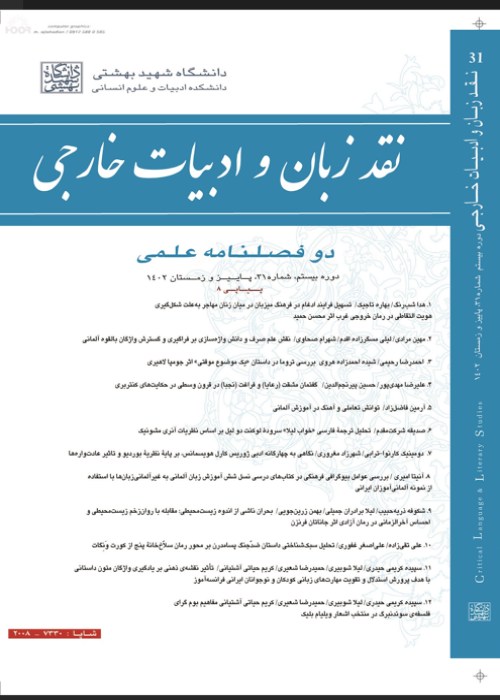The study of Greimas Actional Pattern in Parallel Worlds :1Q84 novel by Haruki Murakami
One of the most important features of postmodern storytelling and surreal literature is cognitive uncertainty or integration of reality and fantasy; Because unlike modern story which emphasizes theme of cognition, postmodern story deepens theme of ontology and that requires confusion of ontological levels and the blurring of boundaries. Haruki Murakami is a contemporary Japanese writer who is interested in expressing various issues of the contemporary world in various novels, and in this regard, he expresses surrealist content and mysteries from the wonders; To the extent that the trajectory of his works, especially the story of 1Q84, can be considered as a kind of inner revelation with parallel worlds.In this research, the story of 1Q84 has been analyzed based on Greimas actional pattern through descriptive-analytical method and we have analyzed the status of narration in the novel according to the pattern of mutual contrastive and narrative chain. The confrontation between the real world and the parallel world puts the main activist in the story of "Aomame" in different confrontational situations. Based on the results of this study, it can be said that in the story of 1Q84, based on Greimas pattern of active, the main activist turned to violence (murder) in order to eliminate the role of the deterrent activist. The main factor in the chain of the story of Aomame's commitment to fight violence and Tango as the author of the second story in the parallel world, to complete the novel of Air pupa is the main factor of the narrationOther events and sub-actions that have a direct impact on the course of the story, especially during the parallel story of "Tango". For example, the current that Aomame and Tango with great faith each seek to change the world around them and believe that "what can be done can not be done" (Murakami, 1396: 84). And also the enemy of Tango and Aomame love, who is shown as a demonic being in the form of a despised person an ugly demon. One of the main features of postmodern narratives in parallel worlds is this ontological uncertainty, that the reader does not know whether the demonic shoes of these "little men" in Murakami's story are born of the narrow mind in the novel "Air Pupa" or exist in the real world, because unlike the story Modernism, which provides the main basis and theme of epistemology, such stories are the border of chaos, and the border of truth and fantasy in their main plot is followed by fuzzy narrative actions. . In Mag Hill's theory, one of the important functions of postmodern fiction is to transform the concept of existence from a simple to a multifaceted and profound concept. The boundary between reality and fantasy, which in the past was inviolable, is broken so that the audience can think about what it is and what it is. The short connection connects these two areas of imagination and reality in such a way that it becomes difficult to distinguish between the two ”(Bamshki, 2016: 34). In Murakami's story, the main and secondary actions of the story are so intertwined that the imaginary world is not opposed to the real world, but this world is real enough. "In a separate chain, attention is paid to the journeys departures and returns, and in general to the course of the story. According to Garmas, most of the stories move from a negative situation to a positive situation. Moving or from a positive situation leads to breaking the covenant ”(Dezfulian, 1398: 27). In the story of 1Q84, according to the Garmas pattern, the detached chain can be considered as follows:A) "Aomame" takes a taxi and encounters heavy traffic on the highway. He accidentally crosses the emergency stairs of an adjacent street and suddenly enters 1984 or 1Q84. There he meets his teenage friend and a widow who help her kill the wicked men of society. Aomame has an emotional and romantic relationship with her childhood friend Tango.B) When the story of the air pupa succeeds by Tango, the narrative journey becomes a positive and pleasant one:Basic progressions: These are the same progressions that are mentioned in parallel at the beginning of the story. These developments are narrated by a third-person narrator and narrate the events that take place along the path of Aomame and Tango.Overlapping progressions (alternative): These progressions are part of the deconstructive elements of the narrative and are in the lower layers due to the surreal and surreal nature of the story, such as extraordinary events that happen to short people and pupa in the story written in Tango or actions and events related to politico-ritual structure. And the Sakigake sect, which has suffocatingly overshadowed space. Sects consider themselves a religious group, but in the words of the author, "it is completely empty of the essence of religion, it is like a theory, a kind of spiritual power of the new age" (Murakami, 1396: 399). These overlapping developments are located in the lower layers of the story and are in fact incorporated in some way through the narrator's interventions in different episodes of the story. In all these developments, "Aomame" and "Tango" act as active activitists.In these progressions, the character of "Aomame" enters a different year called 1Q84 by leaving the real world and going to the parallel world in the heart of stories and adventures outside the real world. This metanarrative layer, which prevents the horizontal course of the story and brings other people into a parallel world, influences the progression of other progressions Haruki Murakami's novel 1Q84 is composed of several actions according to the principle and theory of Greimas action, which are divided into main categories and considering the subject of double interactions. The middle (entering the parallel world) and other sub-actions and the complete unbalanced state (surreal and surreal aspects of the stories in the air pupae and religious groups, etc.) reach a final equilibrium state. Greimas' pattern of action, which consists of six actors, fits well into the story. And are value objects. Actors (editor) and (widow) who help Aomame in killing men are also among the other actors in the story. In most actions, there is no deterrent or opposition force, and there is no dissenting actor to achieve a value object in the story, although a religious and notorious group and sect whose shadow in the parallel world weighs heavily on the actors can be considered somewhat deterrent and dissenting. The formation of narrative in the narrative chains of the story is also more present in the aspect of covenant and covenant, because in this chain, the actors have made a pact within themselves to achieve their goal.
- حق عضویت دریافتی صرف حمایت از نشریات عضو و نگهداری، تکمیل و توسعه مگیران میشود.
- پرداخت حق اشتراک و دانلود مقالات اجازه بازنشر آن در سایر رسانههای چاپی و دیجیتال را به کاربر نمیدهد.



